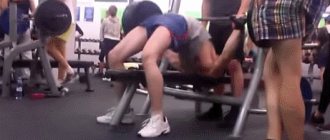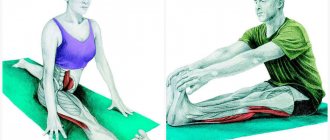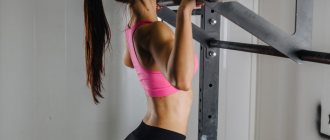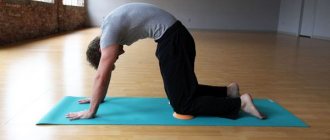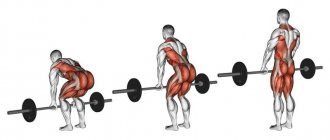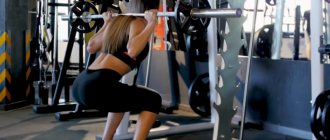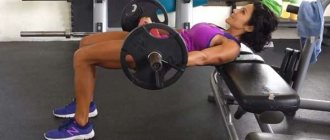What muscles work?
Instructors note the benefits of the plank due to the fact that it engages various muscle groups. Standing on your hands works your biceps and triceps, focusing on your legs strengthens the muscle tissue and the cervical spine, abs, and back are also involved. Various plank options allow you to load and work problem areas, focusing on certain muscles.
Classic plank
If the plank is performed with emphasis on outstretched (or bent) arms and straight legs, then the benefit of this exercise is to work out the abdominal muscles, gluteal and calf muscles, the arms (triceps and biceps) become sculpted, the spine is activated - cervical, lumbar, shoulder belt.
Reverse plank
The inverted version of the exercise creates more emphasis on the arms, which allows you to increase the load on the corresponding muscles. Actively working muscle groups also include the gluteal muscles, the muscles of the back of the thigh, and the calves. The lower back and abs are also involved.
Lateral
This option develops not only the rectus abdominal muscles, but also the obliques. The greatest load falls on the forearms. The quadriceps and calf muscles are slightly less involved.
Reverse plank exercise
24. One-arm plank
25. Plank exercises for 30 days: Three-point plank with body rotation
26. Plank with twist
Plank exercise with alternating leg curls
28. Plank with alternating leg abduction to the side
29. Walking in a plank
Plank slide up
Benefits and harms
The plank can be both beneficial and harmful. Before performing an exercise, it is important to become familiar with its implications and results.
| Benefit | Harm |
|
|
What does it do for men?
Men who include a plank in their training not only note the benefits for developing muscle definition, but also see an increase in endurance. In addition, the exercise allows you to simultaneously use your back, abs, legs and arms without resorting to weights, this is beneficial for those for whom heavy physical activity is contraindicated.
What is the effect for women?
In addition to the already noted benefits, the bar will help you quickly get your body in shape after childbirth - correct your overall silhouette, remove fat deposits on your stomach. The exercise is also effective in the fight against cellulite - the muscles of the thigh and buttocks are tightened. Despite the undoubted benefits, do not forget that in some cases the plank can cause harm to health. This primarily applies to pregnant women - harm can also be done to the child.
Types of planks and technique
Different types of exercises are similar in technique, but they train different muscle groups.
Straight arm plank
Standard version of the exercise. Place a mat on the floor and place your hands palms down. Raise your body so your back and legs should form a straight line. Hold this position for as long as possible, then rest and repeat the approach.
- Lie down on the floor as you would for regular push-ups. Raise your body, resting solely on your palms and toes. A perpendicular line should run from the shoulder along the arm to the floor.
- Your legs should not bend, try to keep them straight.
- The back does not arch or bend, the shoulder blades are slightly lowered. The tailbone should not protrude.
- The abdominal muscles should be in constant tension throughout the entire exercise.
- A small life hack - the further apart you spread your feet, the easier it will be for you to stand in the plank position, but the effectiveness of the exercise will decrease.
- Breathing during execution should be measured and calm.
Elbow plank
A more complex version of the plank, which involves keeping your body weight on your elbows and toes. Elbows are bent at an angle of 90 degrees. When performing the exercise, the body should be parallel to the floor, not sag or bend - it will be easier to keep a straight line if you tense your buttocks. In addition to the abdominal muscles, the muscles of the thigh and lower back, as well as the pectoral muscles, work here.
In this type of plank, basically everything is done in the same way as in the hand plank. The only difference will be that you rely not on your palms and hands, but on your forearms.
- Take your starting position.
- Bend your elbows, place them on the floor and rest on your forearms.
- To make the exercise more difficult, you can lift one leg or arm and keep it parallel to the floor.
- You can connect the plank on your elbows and arms, alternately changing positions - moving from a plank on your hands to a plank on your elbows and back, bending and extending your arms.
Plank with leg or arm extended
This exercise is more difficult because there are now three fulcrum points instead of four. Not only do you have to keep your body in a plank position, but you also have to make sure that the raised leg or arm does not fall below the line of your back. This plank provides a complex load on muscle groups and improves your sense of balance and balance.
Side plank
This version of the plank involves pumping the lateral abdominal muscles and oblique abdominal muscles - they are most involved in the exercise. Make sure that the body is in line with the legs, and the pelvis does not sag down. The feet need to be placed on top of each other, or the leg that is on top should be brought forward.
What will happen if you do it every day?
If you take into account those aspects in which doing the plank can be harmful and make sure of the positive state of your health, then it is recommended to do the exercise as often as possible. When carried out daily, you can see progress and evaluate the benefits for working out the muscle corset, losing weight, and increasing physical stamina.
According to training programs, day by day it is necessary to increase the duration of holding the static position. This has a positive effect on the condition of the spine and gradually improves posture. Benefits are also noted in improved blood circulation.
Will planking help you lose weight?
The effectiveness of the plank for weight loss, like any other exercise, is measured by how much energy you expend on doing it. In other words, you shouldn’t consider it as a magic remedy that will help you lose weight. Dynamic variations of this exercise burn more calories than static ones.
Regular planking, along with diet, helps to get more pronounced results in the process of losing weight.
In general, you can create an entire workout solely from planks. However, such monotony will quickly tire you. Therefore, it would be correct to combine the bar with other physical exercises. The weight loss effect will appear if you spend more energy than you get from food.
Visually, the bar helps make your figure slimmer by toning the abdominal and side muscles. In principle, this provides good help for starting to lose weight.
Contraindications
The plank allows you to pump many muscle groups, but it can be harmful if there are contraindications to its implementation. These include:
- You cannot perform the exercise in the second and third semesters of pregnancy, and in the first you must obtain the recommendations of your doctor.
- Doing the plank during menstruation can be fraught with exacerbation of pain in the abdominal area.
- It is forbidden to do the plank immediately after childbirth; you must endure a rehabilitation period (usually 2 months) before starting the exercise.
- Caesarean section significantly increases the recovery period. The plank will be harmful if done in the first 3 months after childbirth.
- The same recommendations and time frames for recovery should be followed after any surgical intervention in the body.
- For many diseases of the back and lumbar region, it is also recommended to abandon the plank so as not to cause even more harm. Such diseases include hernia of the spine and lumbar region, exacerbations due to osteochondrosis. You need to be careful when doing planks in advanced stages of scoliosis.
- Glaucoma is also a contraindication.
- The plank is a type of arm balance that can be harmful if you have uterine fibroids.
- With diastasis, it is important to observe the restrictions (the recommended variety is the side plank) - increase the load gradually and smoothly exit the rack.
- The plank is prohibited for hemorrhoids, but is acceptable during remission of the disease.
- Exercise will be harmful for varicose veins of the lower extremities.
- The plank, like most physical exercises, is not recommended to be done after eating. 2 hours must pass after eating before you can start training.
- Contraindications also include hypertension.
- Any workout should begin with a warm-up. In order not to harm the muscles, they should be pre-warmed. The plank is no exception in this matter.
- The plank can be dangerous in case of diseases of the spine; it is worth noting that it can cause irreparable harm in case of intervertebral hernia.
- This exercise is not recommended for those who suffer from high blood pressure.
How long to stand in plank
Numerous marathons offer to learn how to stand in a plank for 5 or even 10 minutes in a row in a month. This is not very useful: in an untrained person, the target muscles quickly get tired. The opposite effect is obtained: the load is transferred to the ligaments and stabilizer muscles, the body is held in the desired position due to them, and not due to the muscles that you originally intended to pump.
Therefore, it is better for beginners to stand in the plank in short sets with little rest. For example, if you are doing a plank as part of a warm-up, you should stand for 10-30 seconds, followed by 10 seconds of rest, and perform 2-3 repetitions.
If the plank is part of the workout, and you perform it both statically and dynamically, in different positions, stand in each position for 60 seconds. Under the supervision of a trainer and if you are confident in your abilities, you can increase the duration to 1.5-2 minutes.
If you have back problems, it is better to perform the plank in short sets of 20 seconds with a rest on your knees for 3-5 seconds. You need to perform 5-8 repetitions (depending on your level of training). Doctors also advise performing side planks, alternately on each side, to strengthen the spinal muscles.
What to do if your back hurts?
The main thing is to determine the nature of the pain. One of the manifestations of a positive result may be muscle pain. It is acceptable and indicates progress in muscle development.
If the pain is characterized by acute and continuous outbreaks, then the exercise technique is impaired. In this case, you need to consult a trainer. Or the plank provokes exacerbations of chronic diseases - then you should stop doing the exercise and immediately consult a doctor.
In order not to cause irreparable harm to your health, you should take into account contraindications before doing the plank, monitor sensations, control the load and select an exercise option that matches your level of physical fitness.
How is the exercise performed?
When talking about how to do the plank exercise, you need to take into account that there are several types of it - regular, side, elbow, etc.
They differ from each other in the way they are performed and the load on different parts of the muscles.

